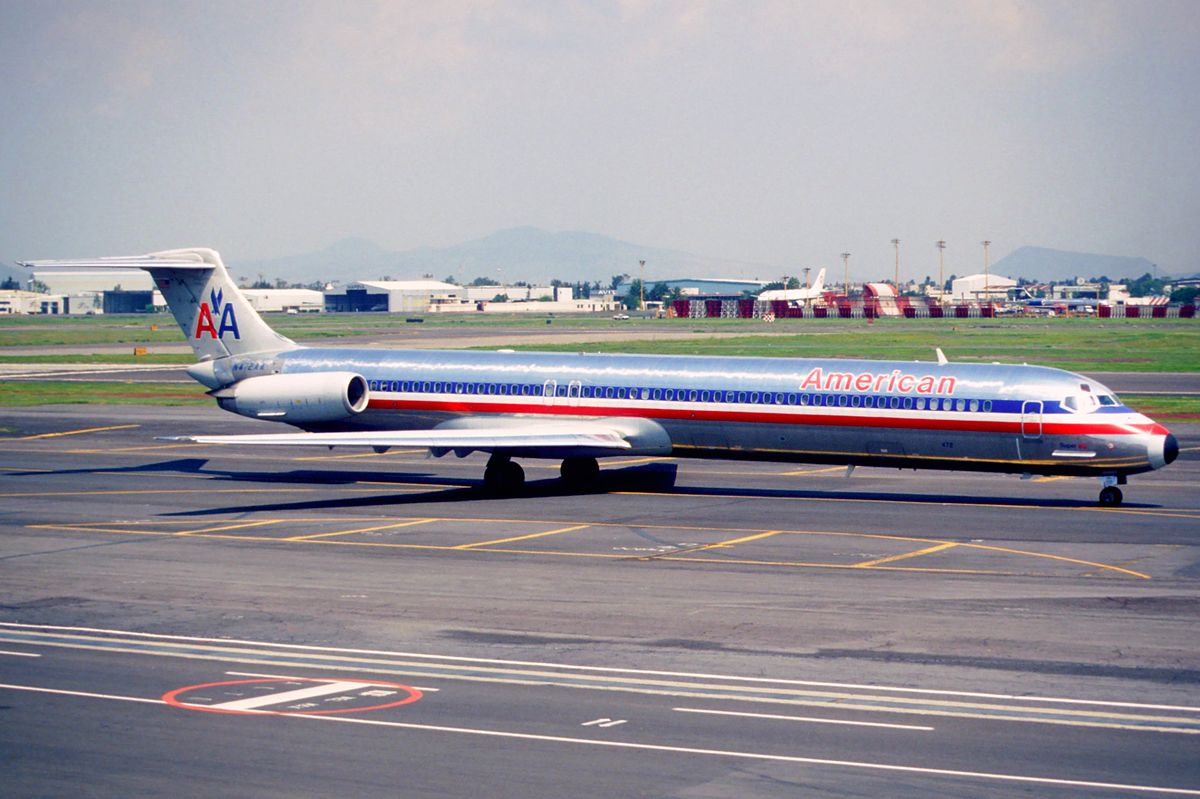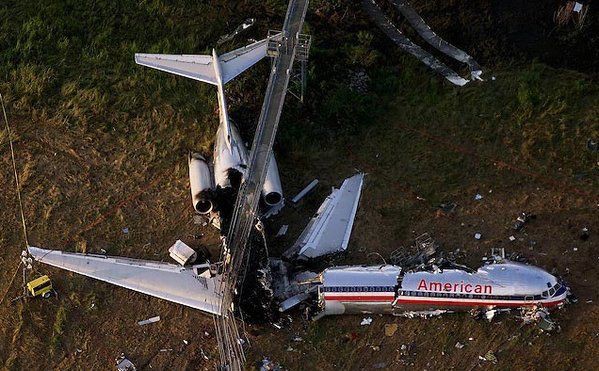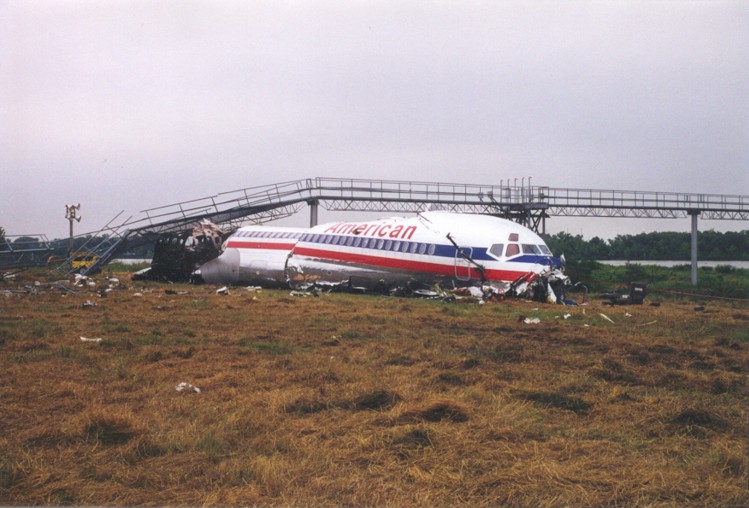1 June 1999 - American 1420
American Airlines Flight 1420 was a flight from Dallas-Fort Worth International Airport to Little Rock National Airport in USA. On June 1, 1999, a McDonnell Douglas MD-82, registration N215AA, overran the runway upon landing in Little Rock and crashed.

The pilots of flight 1420 were Captain Richard Buschmann and First Officer Michael Origel.
According to the NTSB accident report, they learned that the winds were changing direction and that a wind shear alert had sounded on the airport due to a thunderstorm nearby. ATC originally told them to expect Runway 22L for landing, but after the wind direction changed rapidly, Captain Buschmann requested a change to Runway 4R.
As the aircraft approached Runway 4R, a severe thunderstorm arrived over the airport. The controller's last report, prior to the landing, stated that the winds were 330 degrees at 28 knots. That exceeded the MD-82's crosswind limit for landing in reduced visibility on a wet runway. With that information, plus two wind shear reports, the approach should have been abandoned at that point, but Captain Buschmann decided to continue his approach to Runway 4R.
During their rush to land as soon as possible, both pilots became overloaded with multiple necessary tasks. That led to errors and omissions, which proved to be the final links in the accident chain. Consequently they failed to arm the automatic ground spoiler system (hinged panels on top of the wings). The smooth airflow over the top of the wings is disrupted when the spoilers deploy automatically, as the wheels touch the runway. This negates the lifting ability of the wings, thereby making the wheel brakes more effective, by effectively transferring the weight of the aircraft from the wings to its wheels.
The pilots also failed to arm the auto braking system. Both automatic deployment of the ground spoilers and automatic engagement of the brakes are essential to ensure the plane's ability to stop within the confines of a wet runway, especially one that is being subjected to strong and gusting winds.
After landing, First Officer Origel stated, "We're down. We're sliding." The captain then said " Oh No!" Neither pilot observed that the spoilers did not deploy, so there was no attempt to activate them manually. The result was almost no braking at all, since only about 15 percent of the airplane’s weight was supported by the main landing gear.
Directional control was lost when Captain Buschmann applied too much reverse thrust, in contradiction to the limits stated in the flight manual.
The aircraft skidded off the far end of the runway at high speed, slammed into a steel walkway with the landing lights for runway 22L and finally came to a stop on the banks of the Arkansas River.
"After departing the end of the runway, the airplane struck several tubes extending outward from the left edge of the instrument landing system (ILS) localizer array, located 411 feet beyond the end of the runway; passed through a chain link security fence and over a rock embankment to a flood plain, located approximately 15 feet below the runway elevation; and collided with the structure supporting the runway 22L approach lighting system."
Such structures are usually frangible - i.e. designed to shear off on impact - but because the approach lights were located on the unstable river bank, they were firmly anchored and the impact destroyed the aircraft. It broke into three pieces and ignited.
Captain Buschmann was killed instantly, when the cockpit impacted a steel walkway attached to the approach lighting system for Runway 22L. Ten of the 139 passengers also died. An Argentinian child traveling alone escaped from the plane with no injuries.
After the accident American Airlines revised its checklist so that pilots would confirm that the spoilers are armed.

Transcript of the Cockpit Voice Recorder (CVR)
| Time | Source | Content |
| 1145:15 | CAM-1 | I hate droning around visual at night in weather without, having some clue where I am. |
| 1145:23 | CAM-2 | yeah but, the longer we go out here the … |
| 1145:24 | CAM-1 | yeah, I know. |
| 1145:25 | CAM | [sound similar to stabilizer- in- motion horn] |
| 1145:26 | CAM-5 | stabilizer motion. |
| 1145:29 | CAM-2 | see how we're going right into this crap. |
| 1145:31 | CAM-1 | right. |
| 1145:47 | RDO-2 | and approach American fourteen twenty, I know you're doing your best sir. we're getting pretty close to this storm. we'll keep it tight if we have to. |
| 1145:52 | APR | * American fourteen twenty uh, turn right heading of uh, two seven zero. |
| 1145:56 | CAM | [sound similar to stabilizer- in- motion horn] |
| 1145:57 | RDO-2 | two seven zero, American fourteen twenty. |
| 1145:59 | APR | and uh, when you join the final, you're going to be right at just a little bit outside the marker if that's gonna be okay for ya. |
| 1146:04 | CAM-1 | that's great. |
| 1146:05 | RDO-2 | that's great with us. |
| 1146:06 | APR | American fourteen twenty, roger. |
| 1146:11 | CAM | [sound similar to stabilizer- in- motion horn] |
| 1146:11 | CAM-2 | see we're right on the base of these clouds so … |
| 1146:13 | CAM-1 | yeah. |
| 1146:14 | CAM-2 | … it's not worth it. |
| 1146:15 | CAM | [sound similar to stabilizer- in- motion horn] |
| 1146:20 | CAM-2 | two seven zero, two thousand three hundred? |
| 1146:23 | CAM-1 | yes sir. * where I am. |
| 1146:25 | APR | American fourteen twenty, turn right heading three, zero zero. |
| 1146:29 | RDO-2 | right turn three zero zero American fourteen twenty. |
| 1146:39 | APR | American fourteen twenty is uh, three miles from the marker. Turn right heading zero two zero. maintain two thousand three hundred 'til established on the localizer. Cleared ILS runway four right approach. |
| 1146:43 | CAM | [brief sound of Morse Code identifier] |
| 1146:47 | RDO-2 | zero two zero 'til established, American fourteen twenty, cleared four left approach. |
| 1146:52 | CAM-1 | aw, we're goin' right into this. |
| 1146:52 | APR | American fourteen twenty, right now we have uh, heavy rain on the airport. The uh, current weather on the ATIS is not correct. I don't have new weather for ya, but the uh, visibility is uh, less than a mile. runway four right RVR is three thousand. |
| 1146:53 | CAM | [sound similar to stabilizer- in- motion horn] |
| 1147:04 | CAM-1 | three thousand. |
| 1147:04 | RDO-2 | roger that, three thousand, American uh, fourteen twenty. This is four right, correct? |
| 1147:07 | CAM | [sound similar to stabilizer- in- motion horn] |
| 1147:08 | APR | American fourteen twenty, that's correct sir. and runway four right, cleared to land. The wind three five zero at three zero, gusts four five. |
| 1147:10 | CAM-1 | can we land? |
| 1147:16 | RDO-2 | zero three zero at four five, American fourteen twenty. |
| 1147:19 | CAM-2 | ** zero forecast right down the runway. |
| 1147:22 | CAM-1 | three thousand RVR. we can't land on that. |
| 1147:24 | CAM-2 | three thousand if you look at uh… |
| 1147:26 | CAM | [sound similar to stabilizer- in- motion horn] |
| 1147:27 | CAM-1 | what do we need? |
| 1147:28 | CAM-2 | no it's twenty four hundred RVR. |
| 1147:29 | CAM-1 | okay, fine. |
| 1147:30 | CAM-2 | yeah, we're doing fine. |
| 1147:31 | CAM-1 | all right. |
| 1147:34 | CAM-1 | uh, fifteen. |
| 1147:36 | CAM | [sound of clicks similar to flap handle movement] |
| 1147:40 | CAM | [sound similar to stabilizer- in- motion horn] |
| 1147:44 | CAM-1 | lllanding gear down. |
| 1147:46 | CAM | [sound similar to landing gear being operated] |
| 1147:47 | CAM | [sound similar to stabilizer- in- motion horn] |
| 1147:49 | CAM-1 | and lights ** please. |
| 1147:51 | CAM | [sound similar to stabilizer- in- motion horn] |
| 1147:52 | CAM-5 | stabilizer motion |
| 1147:53 | APR | windshear alert, center field wind, three five zero at three two, gusts four five. north boundary wind three one zero at two niner. Northeast boundary wind three two zero at three two. |
| 1148:02 | CAM | [sound similar to stabilizer- in- motion horn] |
| 1148:03 | CAM-5 | stabilizer motion. |
| 1148:04 | CAM-2 | flaps twenty eight? |
| 1148:11 | CAM-1 | add twenty. |
| 1148:13 | CAM-2 | right. |
| 1148:13 | CAM-1 | add twenty knots. |
| 1148:15 | CAM-2 | okay. |
| 1148:13 | APR | American fourteen twenty, the runway four right RVR now is one thousand six hundred. |
| 1148:18 | CAM-2 | aw #. |
| 1148:19 | CAM-1 | well we're established on the final. |
| 1148:21 | CAM-2 | we're established we're inbound, right. |
| 1148:25 | RDO-2 | okay, American fourteen twenty, we're established inbound. |
| 1148:27 | APR | American fourteen twenty roger, runway four right, cleared to land, and the wind, three four zero at three one. north wind, north uh, boundary wind is three zero zero at two six, northeast boundary wind three two zero at two five, and the four right RVR is one thousand six hundred. |
| 1148:37 | CAM | [sound similar to stabilizer- in- motion horn] |
| 1148:42 | RDO-2 | American uh, fourteen twenty, thanks. |
| 1148:44 | CAM-2 | that's a good point. |
| 1148:46 | CAM | [unidentified intermittent tone] |
| 1148:48 | CAM-2 | keep the speed. |
| 1148:51 | CAM-2 | thousand feet. |
| 1148:55 | CAM-1 | I don't see anything. lookin' for four sixty. |
| 1148:59 | CAM | [sound similar to stabilizer- in- motion horn] |
| 1149:01 | CAM-2 | it's there. |
| 1149:03 | CAM-2 | want forty flaps? |
| 1149:05 | CAM-1 | oh yeah, thought I called it. |
| 1149:06 | CAM-2 | forty now. thousand feet. twenty, forty forty land. |
| 1149:11 | CAM | [unidentified tone similar to sound at time 2928] |
| 1149:13 | CAM-1 | this is, this is a can of worms. |
| 1149:11 | APR | wind is three three zero at two eight. |
| 1149:18 | CAM | [sound similar to stabilizer- in- motion horn] |
| 1149:23 | CAM | [sound similar to stabilizer- in- motion horn] |
| 1149:25 | CAM-1 | (I'm gonna stay above it a little) |
| 1149:25 | CAM-2 | there's the runway off to your right, got it? |
| 1149:27 | CAM-1 | no. |
| 1149:28 | CAM-2 | I got the right runway in sight. |
| 1149:31 | CAM-2 | you're right on course. stay where you're at. |
| 1149:32 | CAM-1 | I got it, I got it. |
| 1149:33 | APR | wind three three zero at two five. |
| 1149:38.6 | CAM | -? wipersss. |
| 1149:42.3 | CAM | [sound similar to windshield wiper motion] |
| 1149:47.3 | CAM-2 | five hundred feet. |
| 1149:51.0 | CAM | -? *. |
| 1149:54.6 | CAM-1 | plus twenty. |
| 1149:54 | APR | wind three two zero, at two three. |
| 1149:57.5 | CAM | -? aw #, we're off course. |
| 1149:58.5 | CAM | -? **. |
| 1150:01.4 | CAM-2 | we're way off. |
| 1150:02.5 | CAM-1 | I can't see it. |
| 1150:05.4 | CAM-2 | got it? |
| 1150:06.1 | CAM-1 | yeah I got it. |
| 1150:08.9 | CAM-2 | hundred feet. |
| 1150:10.4 | CAM | -? above. |
| 1150:12.1 | CAM-2 | hundred. |
| 1150:14.66 | CAM-2 | fifty. |
| 1150:13.75 | CAM-5 | sink rate. |
| 1150:15.5 | CAM-2 | forty. |
| 1150:15.16 | CAM-5 | sink rate. |
| 1150:16.8 | CAM-2 | thirty. |
| 1150:18.6 | CAM-2 | twenty. |
| 1150:19.3 | CAM-2 | ten. |
| 1150:21.2 | CAM | [sound of two thuds similar to aircraft touching down on runway concurrent with unidentified squeak sound] |
| 1150:23.2 | CAM-2 | we're down. |
| 1150:25.4 | CAM-2 | we're sliding. |
| 1150:27.1 | CAM-1 | #… #. |
| 1150:32.9 | CAM | -? on the brakes. |
| 1150:34.2 | CAM | -? oh sh … |
| 1150:34.6 | CAM | [sound similar to increase in engine RPM] |
| 1150:36.2 | CAM | -? other one, other one, other one. |
| 1150:42.0 | CAM | -? aw #. |
| 1150:42.7 | CAM | -? ##. |
| 1150:44.9 | CAM | [sound of impact] |
| 1150:45.4 | CAM | -? ##. |
| 1150:48.0 | CAM | [sound of several impacts] |
| 1150:49.1 | END of RECORDING / END of TRANSCRIPT |


